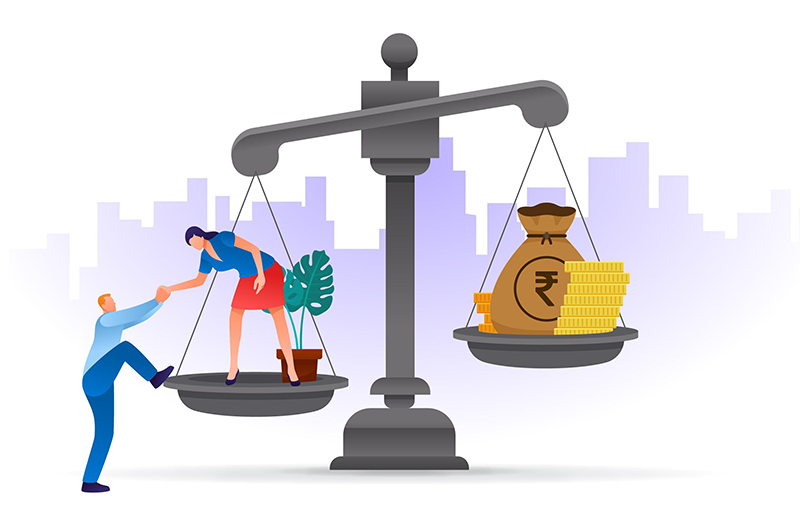Financial Glossary starting with Alphabet C
-
Curreny Hedging
There is a village known as Champak. The village is well known for the intelligence of its people. Chameli is one smart girl of the village and Chatur a smart young man, is keen to marry Chameli. However, Chameli is unwilling to commit. She sets her condition that she might consider marrying him but would confirm only after one year.
She comes up with an idea and makes an offer to Chatur.
She suggests that they draw up a contract which states that at the end of the year she might consider marrying Chatur but there would be no obligation to do so. For signing up the contract, she would pay Chatur a sum of money. As part of the contract, Chatur has to stay within bounds and not persuade her during this period.
If one sees this situation from Chameli's perspective, it appears that she is “Hedging” herself or we may say she is “covering her risks” for a sum of money. Chatur on the other hand stands a chance of marrying Chameli after a year and the sum of money that he gets for the contract becomes the icing on the cake.
However, let us examine the scenario in the event of Chameli not marrying Chatur.
Chameli would use her option of not marrying Chatur if she happens to find a groom more eligible than Chatur. The only price that she would have to bear for this decision is the sum of money that Chatur would get on account of the contract.
So by offering this money, she covers her risks by ensuring that she enjoys the option of marrying either Chatur or somebody better. Chatur has a reasonable chance of marrying Chameli at the end of the year, but if that does not occur he at least gets to pocket the money.
Hedging of currency risk is similar to this story. Let's say Chameli places an order to buy foreign machinery at a million dollars at the end the year. As per the contract, she will need to make the payment at the end of the year. Now let's say the value of a million dollar is 5 cr. rupees at the time of signing the contract.
At the end of the year the value of the dollar rises by 10%. Now she would have to cough up additional Rs. 50 lacs for the machinery (Rs 5.5 cr for a million dollars due to price appreciation).
This increase in cost is not good for her business. And she looks for ways of covering such currency risk. Instead of risking what could be Rs 50 lacs, she buys a call option (you always buy a call option but sell a put option).
This option in essence gives her the option of either purchasing a million dollars for Rs 5 cr. or else allowing the option to expire. Logically, if the value of the million dollars falls below Rs 5 cr, she would allow the option to expire. But if the value of the million dollars goes up beyond Rs 5 cr, she would execute the option.
For getting the benefit of this protection, which is popularly expressed as hedging in the financial terms, she would naturally have to pay a fee or price. Let's say this is Rs 5 lacs (This is just for the sake of illustration. The exact price of the option etc. is beyond the scope of this lesson).
So by risking Rs 5 lacs, she gets the option of purchasing a million dollars either for Rs 5 cr. or less but certainly not more. And for this she would have to pay Rs 5 lacs. If the price of a million dollars were to drop to Rs 4.95 cr. then she would also recover her fee, (Rs 5 lacs) and if the price were to drop to Rs 4.9 cr., she would end up making a profit of Rs 5 lacs. (Her total cost would then be Rs 4.9 cr for a million dollar + Rs 5 lacs as the fee = Rs 4.95 cr. which is Rs 5 lacs less than the agreed price fixed a year ago.)
Otherwise she would risk only Rs 5 lacs in the deal for which she would get a peace of mind by ensuring that the exchange rate for her does not change over the year. This is popularly known as covering the currency risk by way of hedging through the purchase of call options.
Trust this lesson gave you an idea on one of the ways to understand “Currency Hedging”. (Source: Tata Mutual Fund) -
Contract Note
Contract Note is a confirmation of trades done on a particular day on behalf of the client by a trading member/ Stock Broker of the Stock Exchange. It imposes a legally enforceable relationship between the client and the trading member with respect to purchase/sale and settlement of trades. It also helps to settle disputes/claims between the investor and the trading member. It is a Pre- requisite for filing a complaint or arbitration proceeding against the trading member in case of a dispute. A valid contract note should be in the prescribed form, contain the complete details of trades, stamped with requisite value and duly signed by the authorized signatory. Contract notes are kept in duplicate, the trading member and the client should keep one copy each. After verifying the details contained therein, the client keeps one copy and returns the second copy to the trading member duly acknowledged by him.
Apart from physical, the contract notes can also be issued in electronic format and send to Investors to their registered email id -
Contract note - Details
A broker (Stock Exchange member) has to issue a contract note to clients for all transactions in the form specified by the respective stock exchanges. The contract note inter-alia should have following:
- Name, address and SEBI Registration number of the Member broker
- Name of partner/proprietor/Authorised Signatory.
- Dealing Office Address/Tel. No./Fax no., Code number of the member given by the Exchange.
- Contract number, date of issue of contract note, settlement number and time period for settlement.
- Constituent (Client) name/Code Number, address and Demat Account No..
- Order number and order time corresponding to the trades.
- Trade number and Trade time.
- Quantity and kind of Security bought/sold by the client including the ISIN number of the security.
- Brokerage and Purchase/Sale rate.
- Service tax rates, Securities Transaction Tax and any other charges levied by the broker.
- Appropriate stamps have to be affixed on the contract note or it is mentioned that the consolidated stamp duty is paid.
- Signature of the Stock broker/Authorized Signatory.
-
Compound Interest
Compound interest means that, the interest will include interest calculated on interest. The interest accrued on a principal amount is added back to the principal sum, and the whole amount is then treated as new principal, for the calculation of the interest for the next period.
For example, if an amount of Rs. 5,000 is invested for two years and the interest rate is 10%, compounded yearly > Then at the end of the first year the interest would be Rs. 500 (Rs. 5,000 * 0.10)
In the second year the interest rate of 10% will applied not only to Rs. 5,000 but also to the Rs. 500 interest of the first year. Thus, in the second year the interest would be Rs. 550 (0.10 * Rs. 5,500)
For any loan or borrowing unless simple interest is stated, one should always assume interest is compounded. When compound interest is used we must always know how often the interest rate is calculated each year. Generally the interest rate is quoted annually - Example 10% per annum.
Compound interest may involve calculations for more than once a year, each using a new principal, i.e. (interest + principal). The first term we must understand in dealing with compound interest is conversion period. Conversion period refers to how often the interest is calculated over the term of the loan or investment. It must be determined for each year or fraction of a year.
E.g.: If the interest rate is compounded semi-annually, then the number of conversion periods per year would be two. If the loan or deposit was for five years, then the number of conversion periods would be ten.
Formula for calculating Compound Interest:
C = P (1+i)n
Where
C = amount
P = principal
i = Interest rate per conversion period
n = total number of conversion periods
Example:
Mr. Amar invested Rs. 10,000 for five years at an interest rate of 7.5% compounded quarterly
P = Rs. 10,000
i = 0.075 / 4, or 0.01875
n = 4 * 5, or 20, conversion periods over the five years
Therefore, the amount, C, is: C = Rs. 10,000(1 + 0.01875)^20
= Rs 10,000 x 1.449948
= Rs 14,499.48
So at the end of five years Mr. Amar would earn Rs. 4,499.48 (Rs.14,499.48–Rs.10,000) as interest. This is also called as Compounding. Compounding plays a very important role in investment since earning a simple interest and earning an interest on interest makes the amount received at the end of the period for the two cases significantly different.
If Mr. Amar had invested this amount for five years at the same interest rate at simple interest option, then the amount that he would earn is calculated by applying the following formula:
S = P (1 + rt),
P = 10,000
r = 0.075
t = 5
Thus, S = Rs. 10,000[1+0.075(5)] = Rs. 13,750
Here, the simple interest earned is Rs. 3,750
Therefore, Amar is earning Rs. 749.48 (Rs. 4,499.48 – 3,750) -
Credit Spreads
A credit spread refers to the difference in interest rates between a corporate bond and a comparable Government bond. Suppose interest rate on a five-year corporate bond is 6 per cent and that on a similar five-year Government bond is 5 per cent. This means that the interest on a corporate bond consists of a risk-free rate of 5 per cent plus a credit spread of 1 per cent.
Also Different securities in the market have different risk profiles. Therefore, compensation is paid to investors proportionately according to the risk taken by the investor in selecting a particular security.
For Example - Lets say there is a paper issued by the Govt. at 10% coupon. This means if person A subscribes to it, he will earn 10% after one year. So a Rs 100 investment will give him Rs 110 at the end of the year.
Now suppose the Govt. decides to issue papers at 9% a week later. At the same time, person A has a desperate need to get cash and wishes to sell his paper. So he goes to the market to sell the paper.
Now had the Govt. not reduced the coupon rate, he would have probably sold the paper at Rs 100 to some one, say person B, in the secondary market.
But since person B today can earn only 9% coupon for a fresh paper (i.e. Rs 9 for investment of Rs 100) and person A understands this, he tries to sell his paper at approximately Rs 100.5 and make a profit of Rs 0.50.
However why would B agree to this? Let see further…- The buyer, person B, too agrees to buy it at Rs 100.5 because the new rate being offered by the Govt. is 9% whereas at Rs 100.5 he is now earning a better return. How?
- Rs 110 (Value of the paper at the end of the tenure of one year) – Rs 100.5 (Investment) = Rs 9.5 (Absolute Gain)
- Because B chose to buy an old paper (10% coupon) from A from the secondary market, he is better off by making Rs 109.5 at the end of the tenure as against Rs 109 which he would make by investing in a fresh paper from the primary market.
- So as against the 9% return that fresh papers are offering, let us see what return did B manage to get? The return that B will make will be 9.5/100.5 = 9.4% which is better than the market rate of 9%.
- This new rate based on the market price is what is popularly known as “yield”.
- Thus we have seen that when the market price (NAV of MF scheme) goes up the yield actually comes down (from 10% to 9.4%).
Also remember, There will be a spread between two different kinds of papers due to the following reason: - Credit quality – Lending money to the Govt. against its papers is any day safer than lending money to a corporate because the Govt. will never ever default. Hence, one is willing to park one’s money at a lower yield.
- But unusually high spread between papers as seen in the markets these days is due to available money chasing the Govt. papers, a situation that is not likely to be sustained in the long term.
However, the spread between a Govt. and good quality corporate papers isn\'t normally 3%. It is usually around 1.5%. What this means is that the probability of the value of a corporate paper going up in the market is quite high due to the additional spread seen.
So if you buy corporate papers in the current depressed situation, there are good chances that you could make a profit when the spreads reduce as expected.
To Sum Up, The Yield is the income return on an investment. A credit spread is the yield spread, or difference in yield between different securities. When the yield actually comes down the market price (the NAV of a MF scheme) actually goes up. (Source: TATA Mutual Fund) -
Certificate of Deposits
CDs are also called Certificates of Deposit. These are financial instruments. We have heard this time and again.
But what do CDs actually mean? Who issues them?? Who subscribes to them???
Example - Say Amar wishes to borrow Rs. 30 Lakhs for his new business venture by next week. He goes to his bank to ask for the loan. But though the bank agrees to provide a loan, it realizes that it has only Rs. 20 lacs at present. Now the bank does not wish to lose him to another bank. So the bank asks him to come back later to collect the loan amount at let’s say 15%.
So how does the bank provide the additional Rs.10 lakhs?
The bank has corporate relationships from whom they can borrow. In order to borrow, they issue ‘Certificates of Deposit’ to these corporate relationships who in turn subscribe to them. Obviously the rate of interest offered by the bank to the corporate institutions would be higher than the regular fixed deposits. Thus money comes into the bank and is offered to Amar.
CDs, thus, become the financial instrument issued by banks at a higher interest rate than Fixed Deposits to entice corporates to park money with them in order to meet a lending need.
A CD bears, a maturity date, a specified interest rate, and can be issued in any denomination. CDs are generally issued by commercial banks. The term of a CD usually ranges from one month to five years. -
Commercial Papers
A Commercial Paper (CP) is an unsecured, short-term debt instrument issued by a corporation, typically for meeting short-term liabilities.
A Commercial Paper (CP) is a money-market instrument issued by large banks & corporations to garner money from the market to meet short term needs.
When & why was it introduced in India?
It was introduced in India in 1990. It was aimed at providing highly rated corporates with a borrowing option. So while they could borrow from a bank, now with the help of a CP, they could also borrow from the open market. Since CP is used to borrow directly from the market, the rate of interest is lesser as compared to the banks.
Thus, A commercial paper is a lower cost alternative to borrowing from a bank. However not all organizations are in a position to issue CPs. Only reputed organizations whose papers have a good rating can borrow directly through CPs and save money.
Example - Say Future Group, the owner of a large retail store like Big Bazaar, wishes to raise funds from the market to purchase its merchandise. If it were to go to a bank for a loan, then it would probably have to pay around 15% interest on the loan. But from the open market it could perhaps get the loan at only 10%.
Hence by resorting to an instrument like CP, the organization gains 5%.
Therefore, By issuing CPs the organization borrows directly from investors and by-passes the banks. As a result, it gets to borrow at a lower rate from the market as compared to what the banks would have charged.
This process is also called Financial Disintermediation or in other words getting rid of the mediator.
So who is eligible to issue CPs? Corporates, Primary dealers and Financial Institutions (FIs)
And who can invest in CPs? Individuals, Banking companies, Non-Resident Indians (NRIs) and Foreign Institutional Investors (FIIs) etc.
And for what maturity periods are CPs issued? CPs can be issued for maturities between a minimum of 15 days and a maximum of up to one year from the date of issue. Therefore it is used to fund the working capital or current requirements of organizations.
Some other things to remember about CPs…
A major benefit of a CP is that it does not need to be registered with the Securities and Exchange Board of India (SEBI) as long as it matures before nine months (270 days).
However, one important point to note is that the borrowed amount can only be used to fulfill current requirements. It is not meant be used for purchase of fixed assets, such as a new plant.
To Sum Up, A Commercial Paper (CP) is an unsecured money market instrument issued by a corporation or bank in the form of a promissory note. It provides the organization a borrowing option other than a bank. CPs are issued or sold when an organization needs to borrow money for its short term needs. Once a business becomes established, it can issue CPs after having them rated. -
Call-Option
Let’s look at the example of a farmer & bread manufacturer.
A farmer who cultivates wheat And a bread manufacturer who needs wheat as an input for making bread.
The farmer thinks that the price of wheat which is currently trading at Rs. 100 could fall to Rs. 90 in 3 months.
The bread manufacturer on the other hand feels that the price of wheat on the other hand might become Rs. 120 in 3 months.
In such a case, both of them get together & sign a contract which says that at the end of 3 months the bread manufacturer would buy wheat from the farmer at Rs. 110.
Thus the bread manufacturer is protected against a possible rise in prices. And the farmer is protected against any drop in the price of wheat in the near future.
Such a contract is called a Futures contract as we saw in our lesson on ‘Futures’. In a Futures contract both parties are obliged to honor the contract and there is no escape route for either party.
But what if the contract gives the bread manufacturer the “option” of (either) - Buying the wheat from the farmer at the pre-agreed price of Rs 110 (or) - Choosing to exit the contract and buy wheat from the open market at the prevailing market price?
In other words, the bread manufacturer is given the option of not honoring the contract made with the farmer on the date of settlement.
Such a contract that gives the bread manufacturer the option of either executing the contract or exiting it is known as an ‘Options’ Contract. But the bread manufacturer cannot get this privilege just like that. He obviously has to pay a premium for exercising this facility…
Now, let’s say that after 3 months the price of wheat falls to Rs. 90. In this case the bread manufacturer quite clearly would want to exit the contract so that he is free to buy wheat from the open market for Rs. 90.
If so, while the bread manufacturer gets away, the farmer is left high and dry and has no other option but to sell his produce in the open market at Rs 90.
But it is that bad a situation for the farmer as it appears as he gets compensated by the bread manufacturer for having been a party to the ‘Options’ contract. This compensation * in the form of price is called the “Option Premium” that the bread manufacturer has to pay for the Options contract and is usually a small amount.
Let’s assume in our case the amount is Rs 5. So the bread manufacturer is obliged to pay the farmer Rs 5 as he has chosen to opt out of the contract. Thus although the farmer has no other option left but to go to the open market and sell wheat at Rs. 90, he does get the benefit of Rs 5 as compensation for being a party to the ‘Options’ contract.
So even if the price is Rs. 90 in the open market, for him the effective price turns out to be Rs. (90+5) = Rs 95
So by simply participating in the contract he too stands to gain something. For the bread manufacturer, it is a win–win scenario by participating in the contract. Had the prices risen to Rs 120 as he had anticipated, he would have executed the Options contract at Rs 110 and would have got protected.
But since prices fell to Rs 90 he chose to exit the contract. Thus he is blessed with the ‘Option’ of either executing or not executing the contract based upon the price in the open market at the time of contract settlement.
It is important to understand that in an ‘Options’ contract, only one party gets the privilege to exercise the option while the other party is obliged to honor the option if it is chosen. Thus, in our case, the bread manufacturer has the option to either execute or exit the contract whereas the farmer is obliged to honour the decision of the bread manufacturer.
A contract such as this where only the purchaser of the commodity gets the option to either exercise or exit the contract is known as ‘Call’ option.
You will recall we had studied the ‘Put’ option in our last lesson. Hope this explanation has clarified the difference between the ‘Put’ and ‘Call’ option.
Basically in the ‘Put’ option the choice of honoring the contract was with the farmer or seller while in the ‘Call’ option this option was with the bread manufacturer or purchaser. Even in an Options contract both parties land up achieving their goals and their interests are protected.
The bread manufacturer stands to gain the most by getting to exercise a choice that benefits him the most. The farmer on the other hand too benefits by being a party to the contract due to the compensation he receives from the bread manufacturer for not executing the contract.
The farmer due to the compensation sells the wheat in the open market at an effective price of Rs. 95. And hence is better off than the ordinary or spot seller who would have to sell at Rs 90.
Thus in a sense both parties landed up getting some gains by being parties to the ‘options contract’. However unlike in a ‘Futures’ contract, in the ‘Options’ contract one party gains more than the other party.
To Sum Up, In a ‘Futures Contract’ both parties are obliged to honor the contract. In an ‘Options Contract’ one of the parties is given the privilege to exit the option on settlement date and the party has to oblige.
In a ‘Put’ option this privilege is given to the seller (in our example - the farmer)
In a ‘Call’ option this privilege is given to the buyer (in our example - the bread manufacturer) Source: Tata Mutual Fund -
Commodities Hedging
Commodity hedging means reducing or controlling risk arising out of fluctuation in raw-material prices. Commodity hedging is done by taking a position in the futures market that is opposite to the position in physical market. Any manufacturer (buyer) or seller facing the risk of volatile commodity prices can do commodity hedging after compliance with regulatory requirements.
Basically Hedging is a two-step process. A gain or loss in the cash position due to changes in price levels will be countered by changes in the value of futures position.
For instance, a wheat farmer can sell wheat futures at current prices to protect the value of his crop prior to harvest. If there is a fall in price, the loss in the cash market position will be countered by a gain in the futures position. Thus, the farmer meets his objective of ensuring certainty in his revenue
Example - It is July and a farmer expects an unfavorable drop in the selling price of corn. He expects this drop around the time his anticipated production of 15000 baskets of corn are ready for sale in September.
The current price as of July is $4.50 per basket. To hedge his risk of getting a low price for corn, he sells three 5000 basket futures contracts on October corn for more than the current price...say at $5 per basket. When September arrives, prices have actually fallen down to $3.90 a basket.
So, he is now going to receive a much lower price on his corn. To offset this potential loss, he buys corn futures, for $4.60 per basket. If you remember, he had sold corn futures at the price of $5 and he is buying it back at the lower price of $4.60. This is because; price of corn futures has also now come down with the fall in price of corn. So, in futures markets, he has earned a profit of $0.40 due to the difference in his selling and buying prices ($5 sale price - $ 4.60 buying price = $0.40 gain)
Though, he is forced to sell the corn at the reduced price of $3.90 per basket, his effective selling price works out $4.30 per basket ($3.90 + $0.40 profit from futures). So, his effective sales revenue comes to $64500 ($4.30 X 15000 baskets).
He would have lost $6000, if he had not hedged i.e. profit from futures ($0.40 X 15000 = $6000). So, between his cash and futures positions, he has effectively reduced his losses from the price decline. -
Currency Derivatives
Let’s say there is a farmer who grows tea in India, which is exported to the USA.
And there is an importer of tea in the USA.
Let’s assume the current rate of exchange is Rs. 45 for 1 USD. Let us also assume that the tea grower agrees to supply 10 quintals of tea to the importer at 10 dollars a quintal (1 Quintal = 100 kgs.) three months down the line upon harvesting.
It is important to understand that the importer buys tea at 10 dollars a quintal, no matter what the exchange rate is. The tea grower thinks that the rate of exchange, which is currently trading at Rs. 45 to a US dollar, could fall to Rs. 44 in 3 months.
This would mean that while the importer would pay her 100 dollars ( $10 per quintal x 10 quintals = $ 100), as per their business deal, she would earn only Rs. 4400 ( $100 x Rs 44 per dollar) instead of Rs 4500 ( $100 x Rs 45 per dollar) thus incurring a loss of Rs. 100. (Rs. 4500 –Rs. 4400)
In such a scenario, the tea grower goes to a currency trader and signs a ‘forward contract’ which says that at the end of 3 months the currency trader would hedge her against a possible decrease in exchange rates.
This means that, at the end of 3 months, the currency trader would pay her Rs. 4500 for her 100 USD, no matter what the prevailing exchange rate.
Such a contract is called a ‘Currency Derivatives’ contract because it is a currency contract that has to be executed at some future date. Now, let’s look at 3 different scenarios:
1. Say that after 3 months the rate of exchange remains Rs. 45 to a USD. In this case the farmer will take the 100 USD she has received from the importer & go to the currency trader. The trader will pay her Rs. 4500, as per the contract. So the tea grower makes Rs. 4500 in all.
2. Now, let’s look at the 2nd scenario -Say that after 3 months the rate of exchange reaches Rs. 46 to a USD (i.e. $100 = Rs 4600). In this case the farmer’s call was wrong. She will take the 100 USD she has received from the importer & go to the currency trader. The trader will pay her Rs. 4500, as per the contract and would sell off the 100 USD in the market for Rs. 4600, thus making a profit of Rs. 100.
3. Now, let’s look at the 3rd scenario - Say that after 3 months the rate of exchange drops to Rs. 44 to a USD. ($100 = Rs 4400). In this case the farmer’s call was right. She will take the 100 USD she has received from the importer & go to the currency trader.The trader will pay her Rs. 4500, as per the contract thus incurring a loss of Rs. 100.
Thus, while the tea grower may not make any profit if the rupee becomes weaker against the dollar, she will definitely profit if the rupee appreciates & drops below Rs. 45. But at least she would have been at peace for the period of 3 months since she remained protected against any kind of fall in the rupee. (Source: Tata Mutual Fund) -
Capital Gains & Indexation
If you sell an asset such as bonds, shares, mutual fund units, property etc; you must pay tax on the profit earned from it. This profit is called Capital Gains. And, the tax paid on these capital gains is called capital Gains tax. Conversely, if you make a loss on sale of assets, you incur a capital loss.
Types of Capital Gains -
• Short Term capital Gains - If you sell the asset within 36 months from the date of purchase (12 months for shares and mutual funds)
• Long Term Capital Gains – If you sell the asset after 36 months from the date of purchase (12 months for shares and mutual funds)
But, Income Tax laws have a provision of reducing the effective tax burden on long term capital gains that you earn. This provision allows you to increase the purchase price of the asset that you have sold. This helps to reduce the net taxable profit allowing you to pay lower capital gains tax.
The idea behind this is inflation – since we know inflation reduces asset value over a period of time. This benefit provided by Income Tax laws is called ‘Indexation’.
What is Indexation?
Under Indexation, you are allowed by law to inflate the cost of your asset by a government notified inflation factor. This factor is called the ‘Cost Inflation Index’, from which the word ‘Indexation’ has been derived.
This inflation index is used to artificially inflate your asset price. This helps to counter erosion of value in the price of an asset and brings the value of an asset at par with prevailing market price. This cost inflation index factor is notified by the government every year. This index gradually increases every year due to inflation.
How is cost-inflation index computed? ?
The cost inflation index (CII) is calculated as shown:
Inflation Index for year in which asset is sold
CII = --------------------------------------------------------------
Inflation Index for year in which asset was bought. This index is then multiplied by the cost of the asset to arrive at inflated cost.
So let us assume, an asset was purchased in FY 1996-97 for Rs. 2.50 lacs. This asset was sold in FY 2004-05 for Rs. 4.50 lacs.
Cost Inflation Index in 1996-97 was 305 and in 2004-05 it was 480.
So, indexed cost of acquisition would be: Rs. 250,000 X 480/305 = Rs. 393,443
So long Term Capital Gains would be calculated as: Capital Gains = Selling Price of an asset – Indexed Cost
i.e. Rs. 450,000 – Rs. 393,443 = Rs. 56,557
Therefore tax payable will be 20% of Rs. 56,557 which comes to Rs. 11,311.
Had it not been for indexation Capital Gains tax would have been as follows:-
Capital Gains = Selling Price of an asset – Cost of acquisition i.e. Rs. 450,000 – Rs. 250,000 = Rs. 200,000
Therefore tax payable @ 10% of Rs. 200,000 would have come to Rs. 20,000 !!!
So you save Rs. 8,689 in taxes by using the benefit of indexation (Rs. 20,000 – Rs. 11,311)
So you can pay tax on long term capital gains by either of the two methods:-
At the rate of 10% with indexation OR at the rate of 20% without indexation.
Therefore, you need to ascertain which of the two methods would yield lower tax incidence on your capital gains. (Source: Tata Mutual Fund) -
Contra Investing
Contra fund has its genesis in the popular saying,”when others zig you zag”. It basically takes contrasting positions and consciously does not flow with the tide at all times.
Let me tell you a story. There was a boy Raju travelling with his family. They met with an accident in which he lost all his family members. He became orphaned. His relatives turned away from him.
Raman a friend of Raju’s father who knew the family was very fond of Raju. He liked him because he was cultured, well mannered, very studious and always a topper in his class. He knew Raju had the talent to become a very successful person.
He therefore, without any hesitation took Raju under his shelter. He nurtured and educated him sparing no effort. As expected Raju grew up into a very smart, intelligent and successful person.
When Raman started aging and becoming weak it was Raju who stood by him as his shield. He ensured that Raman had all the comforts that he needed.
From a “contra” perspective one can say that the bet Raman took on Raju was a contra bet. He backed him at a time when others were avoiding him. He did it because he had a clearer understanding of the intrinsic qualities of the boy. He always knew it would be worth his while to help Raju in the long term
Similarly a “Contra” fund manager looks for bad news and searches for opportunities within the bad news. He identifies companies being shunned by investors due to overall mood and picks them into his “contra” basket. And as we saw in the case of Raju, such companies also may take some time to bounce back. Therefore, as an investor one needs to have patience when investing in a contra theme.
This was the story of “Contra” investment. Remember it takes patience for the investment to play out (Source: Tata Mutual Fund)









